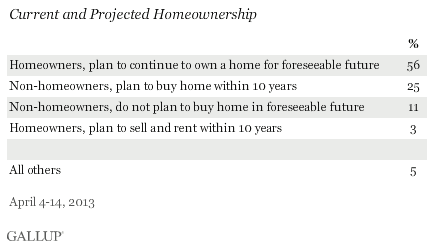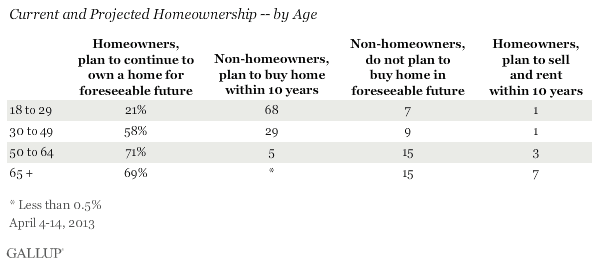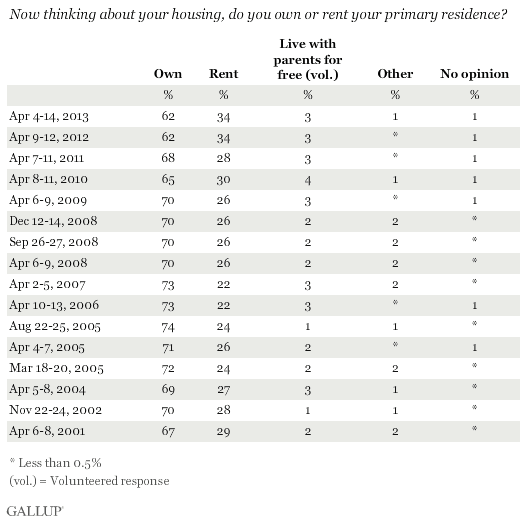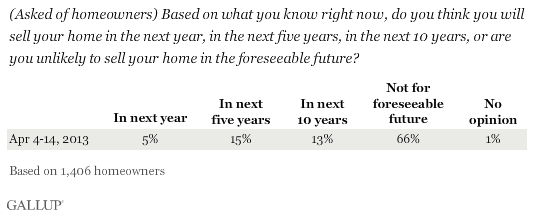PRINCETON, NJ -- Americans' dream of owning a home is alive and well, evidenced by the fact that most Americans own a home and plan to continue to do so (56%), or don't own a home but plan on buying one in the next 10 years (25%). Eleven percent of Americans don't own a home and have no plans to buy one, and 3% own a home but plan on selling it and renting in the next 10 years.

Overall, 62% of Americans say they own their primary residence, with 34% renting and the remainder having other arrangements. Both homeowners and non-homeowners were asked questions about their future plans. The results give little indication of a desire on the part of current American homeowners to sell their home and begin renting, and an apparently strong desire on the part of U.S. non-homeowners to buy a home in the future.
These data are based on Gallup's annual Economy and Personal Finance survey, conducted April 4-14, involving interviews with more than 2,000 Americans and 1,400 homeowners. Gallup earlier this week reported results from this same survey on Americans' perceptions of home values and the key factors they considered in deciding to own a home or to rent. The complete results of the questions on which this analysis is based are included on page 2.
Overall, while 62% of the American population currently owns a home, a considerably larger 81% own a home and express a desire to continue to do so, or don't own a home but express a desire to buy one within the next 10 years. These results certainly suggest that the "American Dream" of owning a home is still very much alive, and that the real estate industry should expect a continuing demand for homeownership in the years ahead.
A number of additional factors could affect the future trajectory of homeownership in the U.S. There will be a continuing stream of young people entering the 18 and older segment of the population going forward, and it is possible that they will have a different attitude toward homeownership than those who came before them. Also, changes in the economy and culture could lead to changes in the way Americans look at their housing, particularly among the huge baby boom generation now entering its senior years.
BIG TRENDS: Read more in our on going series The New American Consumer
Younger Americans Highly Likely to Say They Plan on Buying a HouseNearly 7 in 10 Americans aged 18 to 29 currently do not own a home, but plan on buying one within the next 10 years. Coupling this with the 21% of younger Americans who say they already are homeowners leaves few adults under 30 who say they don't own a home and have no plans on buying one.

The majority of those aged 30 to 49 own their home, and most of the rest say they plan on buying a home in the future. Few (9%) in this age group say they have no plans to buy in the foreseeable future.
The 71% of those aged 50 to 64 who own a home and plan on continuing to own a home in the future is the largest across age groups. Most in this group who want to buy a house apparently have already done so; few (5%) say they don't own a home but are going to buy one. A larger 15% don't own and don't plan on changing that status, while 3% say they will move from homeowner to renter status in the future.
Although it might be expected that a significant number of those 65 and older who currently own a home might plan on selling it in the future and move to renting status, that doesn't appear to be the case. In fact, seven in 10 Americans aged 65 and older own a home and say they will continue to own for the foreseeable future. Although the 7% who plan on selling and becoming renters is the highest of any age group, it's still low on a relative basis.
Homeownership Highly Related to Income
Income is a major predictor of homeownership. Three-quarters of those making at least $75,000 a year own their home and plan on continuing to own, while another 15% say they will buy a home within the next 10 years.

Still, it is apparent that the hope of being able to buy a house is relatively strong even in the minds of those with below-average incomes, given that between 35% and 40% of Americans making less than $50,000 a year say that while they currently don't own a home, they plan on buying one in the future. About a third of those making less than $20,000 a year say they don't own and have no plans to.
Bottom Line
Gallup data on homeownership provide strong support for the idea that the American Dream of owning a home continues to be alive and well. The majority of Americans who own a home plan on continuing to do so in the future, and most of those who don't own a home plan on buying one.
These results align with the finding that the primary reasons why Americans don't own a home are financial, and not a more practical decision that renting is the better way to go.
Gallup has not asked about future homeownership before, so it is unclear whether these attitudes have shifted over the decades -- and particularly whether they are different now than they were before the recent housing crisis. Gallup's long-term trend on owning a home -- 62% of Americans do -- is currently the lowest it has been since the question was first asked in 2001. Thus, some of the desire to buy a home may reflect the fact that a segment of Americans has been shut out of the market due to the mortgage and economic crisis.
Survey Methods
Results for this Gallup poll are based on telephone interviews conducted April 4-14, 2013, with a random sample of 2,017 adults, aged 18 and older, living in all 50 U.S. states and the District of Columbia.
For results based on the total sample of national adults, one can say with 95% confidence that the margin of sampling error is ±3 percentage points.
For results based on the total sample of 1,426 homeowners, one can say with 95% confidence that the margin of sampling error is ±3 percentage points.
Interviews are conducted with respondents on landline telephones and cellular phones, with interviews conducted in Spanish for respondents who are primarily Spanish-speaking. Each sample of national adults includes a minimum quota of 50% cellphone respondents and 50% landline respondents, with additional minimum quotas by region. Landline telephone numbers are chosen at random among listed telephone numbers. Cellphone numbers are selected using random digit dial methods. Landline respondents are chosen at random within each household on the basis of which member had the most recent birthday.
Samples are weighted to correct for unequal selection probability, nonresponse, and double coverage of landline and cell users in the two sampling frames. They are also weighted to match the national demographics of gender, age, race, Hispanic ethnicity, education, region, population density, and phone status (cellphone only/landline only/both, cellphone mostly, and having an unlisted landline number). Demographic weighting targets are based on the March 2012 Current Population Survey figures for the aged 18 and older U.S. population. Phone status targets are based on the July-December 2011 National Health Interview Survey. Population density targets are based on the 2010 census. All reported margins of sampling error include the computed design effects for weighting.
In addition to sampling error, question wording and practical difficulties in conducting surveys can introduce error or bias into the findings of public opinion polls.
View methodology, full question results, and trend data.
For more details on Gallup's polling methodology, visit www.gallup.com.


![(Asked of those who think they will sell their home in the next 10 years) After you sell your home, do you think you will -- [ROTATED: buy a bigger or more expensive home than you own now, buy a smaller or less expensive home than you own now, or rent a place to live]? April 2013 results](http://content.gallup.com/origin/gallupinc/GallupSpaces/Production/Cms/POLL/dbpblydy2kyjzl28nh_n6a.gif)

